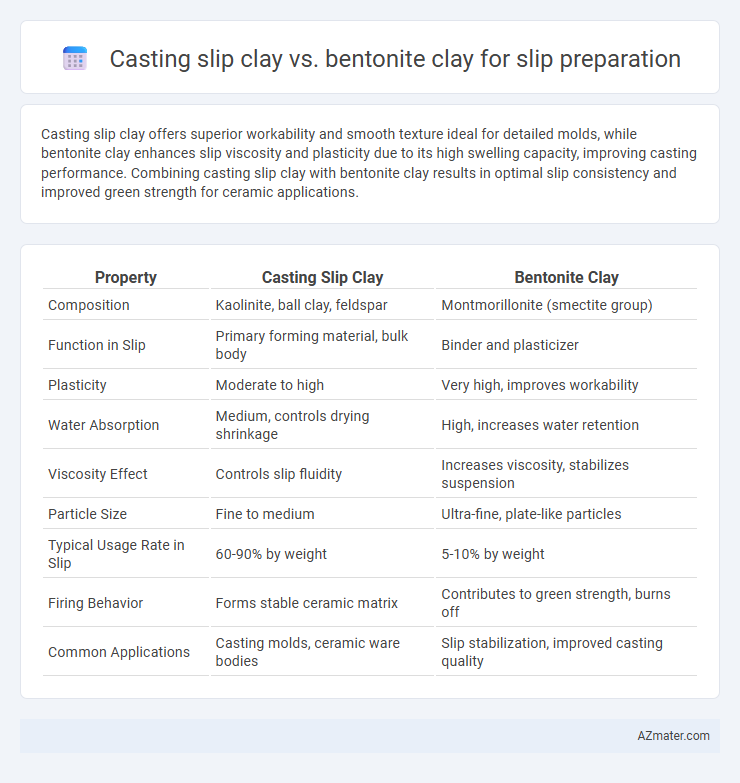Casting slip clay offers superior workability and smooth texture ideal for detailed molds, while bentonite clay enhances slip viscosity and plasticity due to its high swelling capacity, improving casting performance. Combining casting slip clay with bentonite clay results in optimal slip consistency and improved green strength for ceramic applications.
Table of Comparison
| Property | Casting Slip Clay | Bentonite Clay |
|---|---|---|
| Composition | Kaolinite, ball clay, feldspar | Montmorillonite (smectite group) |
| Function in Slip | Primary forming material, bulk body | Binder and plasticizer |
| Plasticity | Moderate to high | Very high, improves workability |
| Water Absorption | Medium, controls drying shrinkage | High, increases water retention |
| Viscosity Effect | Controls slip fluidity | Increases viscosity, stabilizes suspension |
| Particle Size | Fine to medium | Ultra-fine, plate-like particles |
| Typical Usage Rate in Slip | 60-90% by weight | 5-10% by weight |
| Firing Behavior | Forms stable ceramic matrix | Contributes to green strength, burns off |
| Common Applications | Casting molds, ceramic ware bodies | Slip stabilization, improved casting quality |
Introduction to Slip Preparation in Ceramics
Casting slip clay, characterized by finer particle size and lower plasticity, ensures smooth flow and uniform consistency essential for slip casting in ceramics, while bentonite clay, known for its high swelling properties and excellent suspension ability, enhances the slip's viscosity and stability. Proper slip preparation optimizes mold filling, reduces defects, and improves surface finish in ceramic production. Selecting the right clay type balances fluidity and suspension, crucial for effective ceramic slip formulation.
What Is Casting Slip Clay?
Casting slip clay is a finely processed, liquid clay mixture specifically designed for slip casting techniques in ceramics, characterized by its smooth consistency and controlled particle size to ensure even mold filling. Bentonite clay, often added to casting slip, acts as a suspending agent to improve the slip's viscosity and plasticity, enhancing stability during the casting process. The primary purpose of casting slip clay is to create a uniform, defect-free ceramic form by pouring the liquefied clay into plaster molds, where moisture absorption solidifies the shape.
Understanding Bentonite Clay in Ceramics
Bentonite clay is a highly absorbent, natural clay composed mainly of montmorillonite, often used in ceramics to improve the viscosity and suspension properties of slip, making it ideal for casting applications. In slip preparation, Bentonite enhances particle dispersion, resulting in a smoother, more cohesive slip that reduces settling and improves the cast's surface quality. Unlike standard casting slip clay, Bentonite clay's unique swelling capability helps maintain slip stability, ensuring consistent flow and better mold filling during the ceramic casting process.
Key Differences Between Casting Slip Clay and Bentonite Clay
Casting slip clay is primarily formulated for ceramic casting applications, offering a smooth consistency and fine particle size that enhances mold flow and surface finish. Bentonite clay, composed mainly of montmorillonite, acts as a natural binder and suspending agent in slip preparation, providing excellent plasticity and improved particle suspension. Key differences include casting slip clay's optimized formulation for detail replication and ease of de-molding, while bentonite clay contributes superior viscosity control and flocculation properties during slip processing.
Properties and Composition Comparison
Casting slip clay typically consists of fine-grained kaolin and ball clay with lower plasticity, providing smooth flow and ease of casting in ceramic molds. Bentonite clay, composed mainly of montmorillonite, features high swelling capacity and excellent suspension properties, enhancing the viscosity and stability of slip but increasing plasticity. The choice between casting slip clay and bentonite clay hinges on desired slip fluidity, particle dispersion, and drying shrinkage control for optimal ceramic slip preparation.
Mixing and Preparation Techniques for Slip
Casting slip clay requires precise water-to-clay ratios to achieve the right viscosity, typically using low-shear mixing to prevent air bubbles and ensure uniform particle suspension. Bentonite clay, known for its high swelling capacity, is usually pre-dispersed in water before blending with other clay components, creating a more stable suspension and improving slip plasticity. Effective slip preparation balances stirring speed and duration to maintain homogeneity while avoiding over-shear that can degrade particle integrity and affect casting quality.
Advantages of Casting Slip Clay
Casting slip clay offers superior plasticity and smoothness, enabling precise mold reproduction and fine surface detail essential for high-quality ceramics. It exhibits excellent particle suspension, preventing settling and ensuring consistent texture throughout slip application. These advantages result in stronger, defect-free castings with improved shrinkage control compared to bentonite clay-based slips.
Benefits of Using Bentonite Clay in Slip Preparation
Bentonite clay enhances slip preparation by improving suspension stability and preventing particle settling, which ensures a consistent application and avoids defects in ceramic pieces. Its high plasticity and water retention capabilities contribute to better adhesion and smoother texture, facilitating easier shaping and finishing. Using bentonite in slip increases workability and reduces drying shrinkage, resulting in stronger and more durable ceramic products.
Best Applications: When to Use Each Clay Type
Casting slip clay is ideal for ceramic projects requiring smooth, fine textures and precise detail in molds, making it perfect for porcelain and stoneware production. Bentonite clay excels in slip preparation when enhanced viscosity and suspension of solids are needed, often used in slip casting to improve fluidity and control settling during forming processes. Choose casting slip clay for intricate designs needing a fine finish and bentonite clay for applications demanding thicker slips with stable suspension in mass production.
Conclusion: Choosing the Right Clay for Slip Preparation
Casting slip clay offers superior plasticity and smoothness, making it ideal for detailed ceramic casting projects requiring fine surface finishes. Bentonite clay enhances slip viscosity and suspension due to its high swelling capacity, improving particle suspension and workability in slip mixtures. Selecting the right clay depends on desired slip properties: casting slip clay for fine detail and surface quality, bentonite clay for increased adhesion and viscosity in slip formulations.

Infographic: Casting slip clay vs Bentonite clay for Slip preparation
 azmater.com
azmater.com